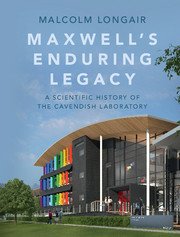Book contents
- Frontmatter
- Dedication
- Contents
- Preface
- Acknowledgements
- Part I To 1874
- Part II 1874 to 1879
- Part III 1879 to 1884
- Part IV 1884 to 1919
- Part V 1919 to 1937
- Part VI 1938 to 1953
- 11 Bragg and the war years
- 12 Bragg and the post–war years
- Part VII 1953 to 1971
- Part VIII 1971 to 1982
- Part IX 1984 to 1995
- Part X 1995 to present
- Appendix The evolution of the New Museums site
- Notes
- References
- Author index
- Subject index
11 - Bragg and the war years
from Part VI - 1938 to 1953
Published online by Cambridge University Press: 05 July 2016
- Frontmatter
- Dedication
- Contents
- Preface
- Acknowledgements
- Part I To 1874
- Part II 1874 to 1879
- Part III 1879 to 1884
- Part IV 1884 to 1919
- Part V 1919 to 1937
- Part VI 1938 to 1953
- 11 Bragg and the war years
- 12 Bragg and the post–war years
- Part VII 1953 to 1971
- Part VIII 1971 to 1982
- Part IX 1984 to 1995
- Part X 1995 to present
- Appendix The evolution of the New Museums site
- Notes
- References
- Author index
- Subject index
Summary
Lawrence Bragg at Manchester and the National Physical Laboratory
The Vice-Chancellor of Manchester University, Sir Henry Miers, having been Professor of Crystallography, was keen to develop the discipline. In his words,
In my opinion, the importance of the study of crystals has now become so great, not only for the identification of substances by crystal measurements but also on account of the new knowledge which modern crystal study is contributing to problems belonging to different sciences, that there is a real need for a department of pure crystallographic research, one in which such studies can be carried out quite independently of elementary teaching or of immediate applications, and without being tied to mineralogy. (Quoted by Phillips, 1979)
Lawrence Bragg, although only 29, was the obvious choice to succeed Rutherford as the Langworthy Professor of Physics at the University in 1919, but it was to prove a real challenge. He had never taught physics and now was in charge of a large department which had become a leader in the dynamic field of nuclear physics under Rutherford. Despite a rocky ride in getting on top of teaching and the management of the growing laboratory during his first few years, he now had his own research laboratory and concentrated upon making the discipline of crystallography an exact quantitative science. This was to be his major and distinguished contribution during his Manchester years. As expressed by David Phillips,
Bragg's unique contribution here was to see the value of making experimental measurements of the absolute intensities of the X-ray reflexions which showed directly the effective number of electrons contributing to each reflexion. The work on rock-salt also stimulated work on the theoretical derivation of the atomic scattering factors that were needed to calculate the intensities of reflexions corresponding to any model structure for comparison with the observed values. (Phillips, 1979)
His research programme got off to an excellent start with his acquisition of a new Xray spectrometer and the gift of a state-of-the-art Coolidge X-ray tube from the General Electric Company at Schenectady. From his continuing studies of crystalline structures, he developed the concept of the sizes of the common ions so that interatomic distances in atomic compounds could be determined by an additive law; these dimensions agreed quite well with the measured atomic distances (Bragg, 1921).
- Type
- Chapter
- Information
- Maxwell's Enduring LegacyA Scientific History of the Cavendish Laboratory, pp. 253 - 271Publisher: Cambridge University PressPrint publication year: 2016



